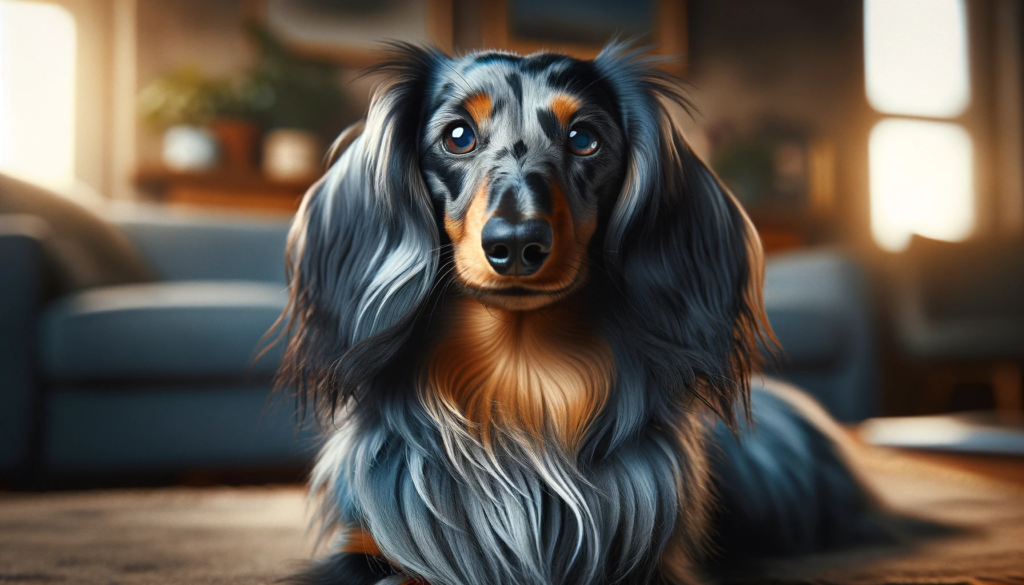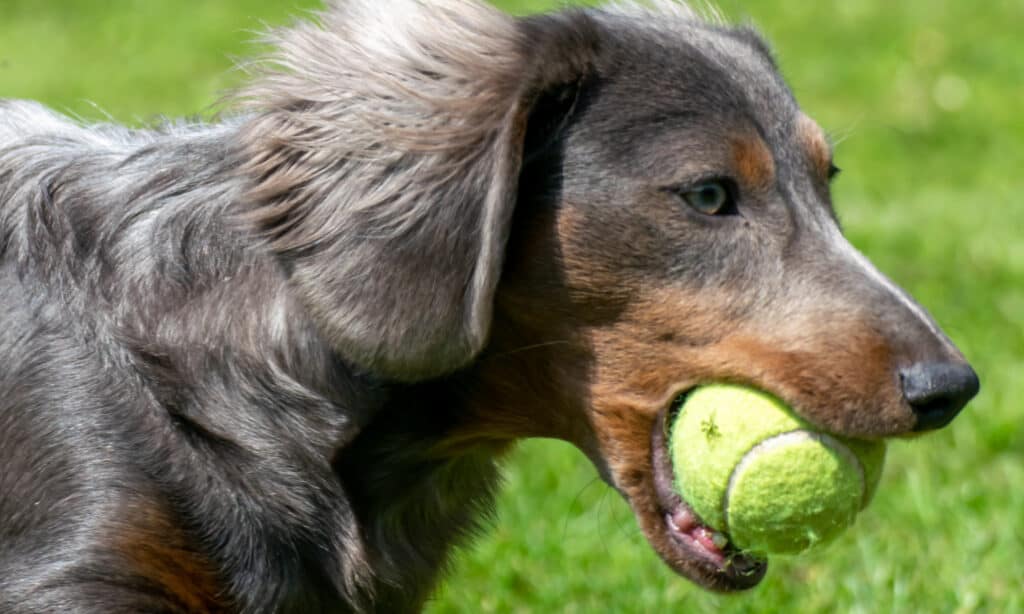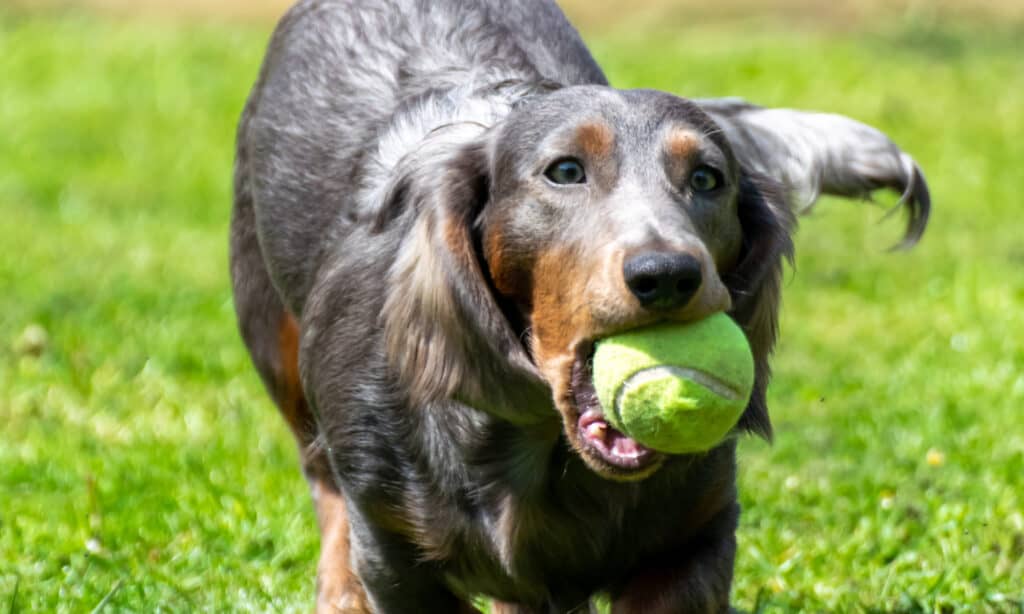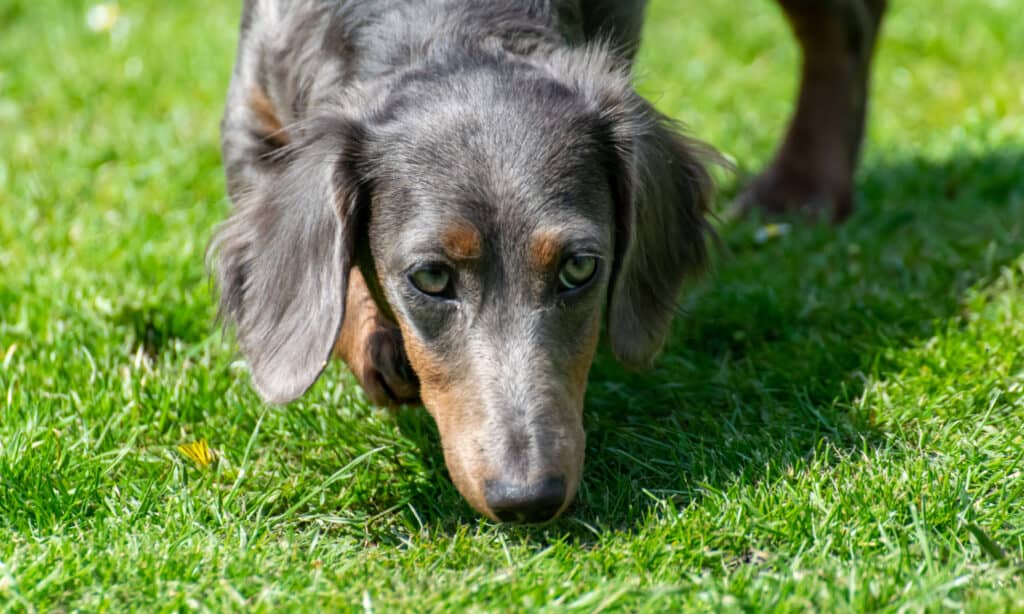Welcome to the ultimate breed guide for Blue Longhaired Dachshunds! If you’re considering adding one of these adorable pups to your family, or are simply curious about this unique breed, you’ve come to the right place.
Dachshunds, or “wiener dogs” as they’re affectionately known, are a popular breed due to their distinctive long, low-slung bodies and friendly personalities. Blue Longhaired Dachshunds are a particularly stunning variety, with their beautiful, flowing coats and striking blue-grey coloring.
In this guide, we’ll delve into the history and origins of the Blue Longhaired Dachshund breed, their physical and personality traits, and the best ways to care for and train these lovable dogs. We’ll also explore some common health concerns to look out for and provide tips on how to keep your Blue Longhaired Dachshund happy and healthy.
Whether you’re a first-time dog owner or a seasoned pro, this guide is sure to provide you with all the information you need to fully appreciate and enjoy the wonderful world of Blue Longhaired Dachshunds. So, let’s dive in and discover all there is to know about this fascinating breed!

History of the Blue Longhaired Dachshund
The Blue Longhaired Dachshund is a newer variation of the Dachshund breed that has its roots in Germany back in the 15th century. Originally bred for hunting, these dogs were skilled at catching small game like rabbits and badgers, thanks to their long, narrow bodies and strong legs.
The Blue Longhaired Dachshund is the result of intentional breeding efforts aimed at creating a unique blue-grey coat color. Although this variation only emerged in the United States in the 1970s, it has quickly become a popular choice for families who want a friendly, loyal companion.
While the Dachshund breed has a history of serving other purposes like tracking wounded animals and providing security as a watchdog, they are now primarily kept as beloved family pets. Blue Longhaired Dachshunds are small in size but big on courage and determination. They make excellent companions for families who give them proper training and socialization.
What is the Blue Longhaired Dachshund coloration?
The Blue Longhaired Dachshund has a beautiful and unique coat that is soft to the touch and ranges in color from a light silvery-blue to a dark slate-grey. This coloration is the result of selective breeding efforts aimed at creating a distinct blue-grey hue that stands out from other Dachshund variations.
Their long, flowing hair requires regular grooming to keep it healthy and free of tangles. The long hair is a recessive trait that is passed down from both parents, which means that not all Blue Longhaired Dachshunds will have long hair.
In addition to their stunning coat, Blue Longhaired Dachshunds are also known for their friendly personalities, loyalty, and intelligence. They make wonderful companions for those who are willing to put in the time and effort to properly care for them.

Blue Longhaired Dachshund Temperament
The blue dachshund is a friendly and outgoing breed that loves being part of the family. They are known for their loyalty and affectionate nature, and make great companions for those seeking a furry friend.
While they generally have a good-natured disposition, dachshunds can be independent and stubborn at times. Proper training and socialization can help ensure they behave well and listen to their owners.
Due to their instincts as hunting dogs, Dachshunds may bark excessively or chase small animals. However, with positive reinforcement and consistent training, they can learn to.
Longhaired Dachshunds are charming and playful pets that can bring a lot of joy and happiness to any household. They are a great choice for families who are willing to put in the time and effort to properly care for them.
Should You Choose To Rescue or Purchase a Blue Longhaired Dachsund?
When deciding whether to rescue or purchase a Blue Dachshund, it’s important to consider what you are looking for in a furry companion.
Rescuing a dog can be a wonderful way to provide a loving home to an animal in need. Adopting from a shelter or rescue organization can offer a chance to give a second chance to a dog that may have had a tough start in life. However, it’s important to understand that rescued dogs may require more time and patience as they adjust to their new environment.
On the other hand, purchasing a Blue Dachshund from a reputable breeder can ensure that you receive a puppy with a known genetic history and a clean bill of health. However, it’s important to research breeders carefully to ensure they are responsible and humane in their breeding practices.
Ultimately, the decision to rescue or purchase a Blue Dachshund should be made with careful consideration of your individual circumstances and preferences. Regardless of which route you choose, the most important thing is to provide a loving, healthy, and happy home for your new furry friend.

What Should You Look For if Purchasing a Blue Longhaired Dachshund?
If you’re planning to buy a dachshund, here are some things to look for:
- Reputable breeder: Look for a breeder who genuinely cares about their dogs’ well-being. Check out their reputation, ask around, and read reviews from other customers.
- Good health: The puppy’s parents should have undergone health screenings for common Dachshund health issues, and the puppy should look healthy and happy with bright eyes and a shiny coat.
- A friendly temperament: A dachshund should be outgoing, playful, and happy. Observe the puppy’s behavior and meet the parents if possible to see what their temperaments are like.
- Good movement: A dachshund should move with ease and balance, without any signs of discomfort or lethargy.
- Proper documentation: The breeder should provide you with all the necessary documents, such as health certificates and vaccination records, so you can be sure your new furry friend is healthy and happy.
By keeping these things in mind, you can find a Blue Longhaired Dachshund that will be a wonderful addition to your family.
How Much Does a Blue Longhaired Dachshund Cost?
The cost of a dachshund can vary depending on several factors, such as the breeder, location, and the puppy’s lineage. On average, you can expect to pay anywhere from $500 to $3000 for a Blue Longhaired Dachshund puppy from a reputable breeder.
It’s important to note that while purchasing a puppy from a breeder can be more expensive than adopting from a shelter, it ensures that you get a dog with a known genetic history and a clean bill of health. Additionally, a reputable breeder will provide you with necessary documentation, such as health certificates and registration papers.
It’s crucial to avoid purchasing a Blue Dachshund from an unscrupulous breeder who may be breeding dogs for profit without regard for their health and well-being. Always research the breeder carefully and ask for references from previous buyers to ensure you get a healthy and well-bred puppy.

Are Blue Longhaired Dachshunds Healthy?
Overall, dachshunds are generally healthy dogs. However, like all dog breeds, they may be prone to certain health issues.
One common health issue in dachshunds is intervertebral disc disease (IVDD). This is a spinal condition that can lead to paralysis and may require surgery to treat. Other health issues that can affect Blue Longhaired Dachshunds include eye problems, hip dysplasia, and dental issues.
It’s important to purchase a dachshund from a reputable breeder who conducts health screenings on their breeding dogs and can provide documentation of their health and genetic history. Regular veterinary check-ups and preventative care can also help ensure your Blue Longhaired Dachshund stays healthy throughout their life.
Proper nutrition, regular exercise, and maintaining a healthy weight can also help prevent health problems in Blue Longhaired Dachshunds. It’s important to work with a veterinarian to develop a health and wellness plan that is tailored to your dog’s individual needs.
With proper care and attention, dachshunds can lead happy and healthy lives as loving companions.
What is the Lifespan of a Blue Longhaired Dachshund?
The lifespan of a dachshund can vary, but on average, they typically live for 12 to 16 years. With proper care and attention, you can help ensure that your furry friend lives a long and happy life.
To maximize your dachshund’s lifespan, it’s important to provide them with a healthy diet, regular exercise, and preventative healthcare. Regular vet check-ups, vaccinations, and dental care can all help prevent health problems and detect any issues early.
It’s worth noting that like all dogs, Blue Longhaired Dachshunds can be prone to certain health issues that can affect their lifespan. By purchasing your dachshund from a reputable breeder who conducts health screenings on their breeding dogs, you can help reduce the risk of any genetic health issues.
By giving your furry friend the love and care they deserve, you can help ensure they live a long and happy life as a cherished companion.

Nutrition for Blue Longhaired Dachshunds
Good nutrition is essential for the health and well-being of dachshunds. Providing your furry friend with a balanced diet can help maintain their weight, boost their immune system, and improve their overall health.
One of the best ways to provide optimal nutrition for your dachshund is to feed them a whole food, fresh diet. This type of diet includes fresh fruits and vegetables, high-quality proteins, and healthy fats. Avoid feeding your dog processed foods or foods with fillers and artificial ingredients.
A whole food, fresh diet can provide a wide range of nutrients that are essential for your dachshund’s health. For example, fresh fruits and vegetables are a great source of vitamins and antioxidants, which can boost the immune system and protect against disease.
In addition to a healthy diet, it’s also important to provide your Blue Longhaired Dachshund with fresh, clean water at all times. Dehydration can lead to serious health problems, so make sure your dog always has access to fresh water.
If you’re not sure what type of diet is best for your dachshund, consult with your veterinarian. They can help you determine the appropriate amount and type of food to feed your furry friend based on their age, weight, and activity level.
By providing your pup with a whole food, fresh diet and access to clean water, you can help ensure they lead a healthy and happy life as a beloved companion.
Exercise and Physical Activity for Blue Longhaired Dachshunds
Physical activity and exercise are important for the health and well-being of your pup. These dogs are generally active and playful, and require daily exercise to maintain their physical and mental health.
Regular exercise can help prevent obesity, boost their immune system, and improve their overall health. Some great activities for dachshunds include daily walks, playing fetch, and interactive games such as hide-and-seek.
It’s important to ensure that your pup gets enough exercise, but it’s equally important not to overdo it. These dogs are prone to spinal issues, and excessive jumping or strenuous exercise can put them at risk for injury. Consult with your veterinarian to determine the appropriate level of exercise for your dog.
It’s also important to provide your dachshund with mental stimulation in addition to physical exercise. These dogs are intelligent and enjoy puzzles, games, and interactive toys that challenge their minds.

Grooming Requirements for Blue Longhaired Dachshunds
Blue Longhaired Dachshunds have a beautiful and distinctive coat that requires regular grooming to keep it healthy and looking its best. Here are some grooming requirements for Longhaired Dachshunds:
- Brushing: Regular brushing is essential to maintain a Longhaired Dachshund’s coat. A pin brush or slicker brush can be used to remove tangles and loose fur. Brushing should be done at least once a week, and more frequently during shedding season.
- Bathing: Longhaired Dachshunds should be bathed every 3 to 4 months, or as needed. Use a mild dog shampoo and rinse thoroughly to avoid any irritation or dryness.
- Nail Trimming: Long nails can cause discomfort and even lead to injury in Longhaired Dachshunds. Regular nail trimming, about once a month, can help prevent these issues.
- Ear Cleaning: Blue Longhaired Dachshunds are prone to ear infections, so it’s important to clean their ears regularly. Use a cotton ball or soft cloth and a gentle ear cleaner recommended by your veterinarian.
- Dental Care: Dental hygiene is important for the overall health of dachshunds. Brush their teeth regularly with a soft-bristled toothbrush and toothpaste made for dogs.
It’s also important to check your Longhaired Dachshund’s coat and skin regularly for any signs of fleas, ticks, or other skin irritations. Consult with your veterinarian if you notice any unusual lumps, bumps, or skin conditions.
By following these grooming requirements, you can help keep yourpup’s Blue Longhaired Dachshund’s coat and skin healthy and looking their best.
Are Blue Longhaired Dachshunds Hard to Train?
Dachshunds can be somewhat challenging to train due to their independent nature and stubbornness. However, with patience, consistency, and positive reinforcement, they can be trained successfully.
Dachshunds, in general, are known for their strong will and determination, which can make them challenging to train at times. They may also have a tendency to bark excessively or exhibit other undesirable behaviors if not properly trained.
Early socialization and obedience training can help prevent these issues and make training easier. Positive reinforcement methods, such as rewards and praise, are particularly effective with Blue Longhaired Dachshunds, as they respond well to positive feedback.
It’s also important to keep training sessions short and consistent, as dachshunds can become easily bored or distracted. Regular exercise and mental stimulation can also help improve their focus and make training more effective.
Most Common Behavior Issues of Blue Longhaired Dachshunds
Like all dog breeds, Blue Longhaired Dachshunds may be prone to certain behavior issues. Here are some of the most common behavior issues of Blue Longhaired Dachshunds:
- Separation anxiety: Blue Longhaired Dachshunds can be prone to separation anxiety. They become distressed or anxious when left alone. This can lead to destructive behavior, excessive barking, and other issues.
- Excessive barking: Blue Longhaired Dachshunds may bark excessively, especially if they are not properly trained or socialized. This can be a nuisance for owners and neighbors.
- Digging: Blue Longhaired Dachshunds may have a natural inclination to dig, which can be destructive to lawns and gardens.
- Aggression: While not common, Blue Longhaired Dachshunds may exhibit aggression towards people or other dogs if not properly socialized or trained.
- Stubbornness: Blue Longhaired Dachshunds can be stubborn and independent, which can make training and obedience challenging.
It’s important to address these behavior issues early on to prevent them from becoming more serious problems. Positive reinforcement training methods and early socialization can help prevent behavior issues. It can create a well-behaved and well-adjusted Blue Longhaired Dachshund.
If you’re struggling with behavior issues with your Blue Longhaired Dachshund, consult with a professional dog trainer or behaviorist who can provide guidance and support. With patience and consistency, you can help your Blue Longhaired Dachshund overcome any behavior issues and enjoy a happy and healthy life as a beloved companion.

Training Tips for Blue Longhaired Dachshunds
Training a Blue Longhaired Dachshund can be challenging, but with the right approach and consistency, it’s possible to train them successfully. Here are some training tips for Blue Longhaired Dachshunds:
- Use positive reinforcement: Positive reinforcement is a highly effective training method for Blue Longhaired Dachshunds. Use rewards such as treats, praise, and playtime to reinforce desired behaviors.
- Keep training sessions short: Blue Longhaired Dachshunds have short attention spans. It’s important to keep training sessions short and focused. Aim for several short training sessions per day rather than one long session.
- Be patient: Blue Longhaired Dachshunds may be stubborn and independent, so it’s important to be patient during training. Avoid getting frustrated or angry and instead focus on positive reinforcement and consistency.
- Socialize early: Early socialization is important for Blue Longhaired Dachshunds to prevent behavior issues such as aggression or excessive barking. Introduce your dog to new people, dogs, and environments at an early age to help them become well-adjusted and confident.
- Use consistency: Consistency is key when training a Blue Longhaired Dachshund. Use the same commands and training methods consistently to help your dog understand what is expected of them.
- Incorporate mental stimulation: Blue Longhaired Dachshunds are intelligent dogs and enjoy mental stimulation. Incorporate puzzle toys, interactive games, and training exercises that challenge their minds.
Remember that training a Blue Longhaired Dachshund requires patience, consistency, and positive reinforcement. With the right approach and plenty of love and attention, you can successfully train your Blue Longhaired Dachshund and enjoy a happy and well-behaved companion.
Conclusion
In conclusion, Blue Longhaired Dachshunds are a unique and wonderful breed of dog. They have a distinctive coat and are known for their loyalty, intelligence, and playful nature. However, as with any breed, they do have their specific needs and considerations that potential owners should be aware of before bringing one into their home.
Proper nutrition, exercise, and grooming are all essential for the health and well-being of Blue Longhaired Dachshunds. They can be somewhat challenging to train, but with patience and consistency, they can be successfully trained using positive reinforcement methods.
Potential owners should also be aware of common behavior issues that can arise with Blue Longhaired Dachshunds, such as separation anxiety and excessive barking. Early socialization and training can help prevent these issues and create a well-behaved and confident companion.
Whether you choose to rescue or purchase a Blue Longhaired Dachshund, providing them with a loving and nurturing environment is key to their happiness and well-being. With proper care and attention, Blue Longhaired Dachshunds can make wonderful and loyal companions for many years to come.
~Lindsie
